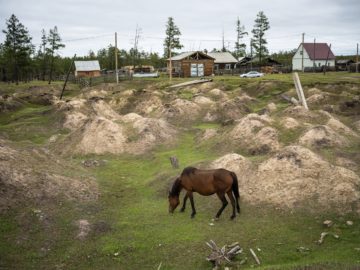Joshua Yaffa in The New Yorker:
 It was impossible to tell through the Antonov’s dusty porthole, but below me the ground was breathing, or, rather, exhaling.
It was impossible to tell through the Antonov’s dusty porthole, but below me the ground was breathing, or, rather, exhaling.
Three million years ago, as continent-size glaciers pulsed down from the poles, temperatures in Siberia plunged to minus eighty degrees Fahrenheit and vast stretches of soil froze underground. As the planet cycled between glacial and interglacial periods, much of that frozen ground thawed, only to freeze again, dozens of times. Around eleven and a half millennia ago, the last ice age gave way to the current interglacial period, and temperatures began to rise. The soil that remained frozen year-round came to be known as permafrost. It now lies beneath nine million square miles of Earth’s surface, a quarter of the landmass of the Northern Hemisphere. Russia has the world’s largest share: two-thirds of the country’s territory sits on permafrost.
More here.
